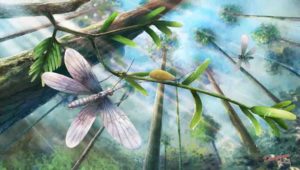
Pioneering new research has given an illuminating new insight into the metallic, iridescent colours found on the earliest known ancestors of moths and butterflies, which habited the earth almost 200 million years ago.
An international team of researchers, including Dr Tim Starkey from the University of Exeter, have discovered new evidence for colour in Mesozoic fossils.
The structural colours of the fossils studied resulted from light scattering by intricate microstructures, extending the evidence for these light-scattering structures in the insect fossil record by more than 130 million years.
The research team examined fossilised remains dating back 180 million years, with some specimens originating from the Jurassic Coast, only a short distance from Exeter.
Using powerful electron microscopes and using optical models, the team found microscopic ridges and grooves in the insect’s wing scales, similar to those seen in today’s moths. Models revealed these tiny features are photonic structures that would have produced metallic bronze to golden colour appearances in the insect wings.
The research is published in leading journal Science Advances on Wednesday, April 11 2018.
Insects have evolved an amazing range of photonic structures that can produce iridescence, metallic colours, and other flashy effects that are important for behaviour and ecological functions.
Dr Starkey, part of Exeter’s Physics and Astronomy department, said: “The structural colours exhibited by butterflies and moths have been a longstanding research interest in Exeter, and have helped us develop biologically-inspired optical technologies for the present day.
“However, in this study we’ve looked millions of years back in time to early origins of such colours in nature, to understand how and when the evolution of colours in these insects took place.”
The study was co-authored by palaeontologists Drs Maria McNamara and Luke McDonald from UCC, in Ireland. Dr McNamara added: “Remarkably, these fossils are among the oldest known representatives of butterflies and moths.
“We didn’t expect to find wing scales preserved, let alone microscopic structures that produce colour. This tells us that colour was an important driving force in shaping the evolution of wings even in the earliest ancestors of butterflies and moths.”
Dr McDonald, previously of the Natural Photonics group in Exeter, said; “Uniquely in this study, we show that impression fossils, i.e. wing prints, are equally as capable as compression fossils at preserving the structure of scales in sufficient detail to elucidate the moths’ 180 million year old colours.”
Reference:
Qingqing Zhang et al. Fossil scales illuminate the early evolution of lepidopterans and structural colours. Science Advances, 2018 DOI: 10.1126/sciadv.1700988
Note: The above post is reprinted from materials provided by University of Exeter.










